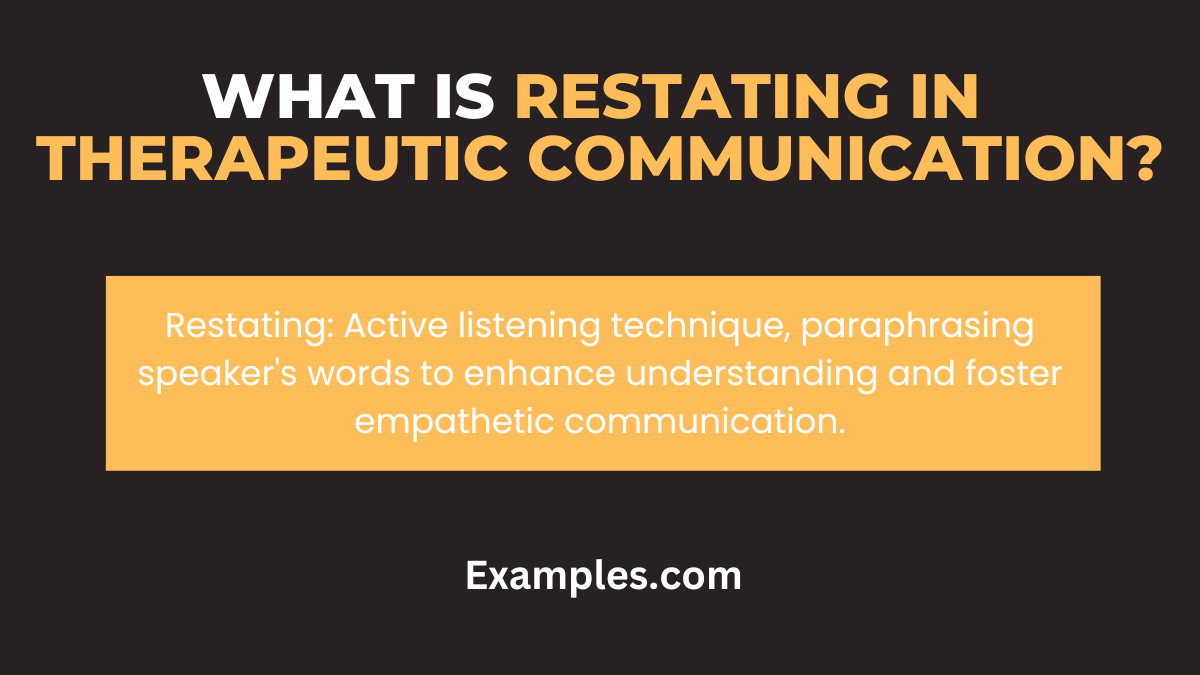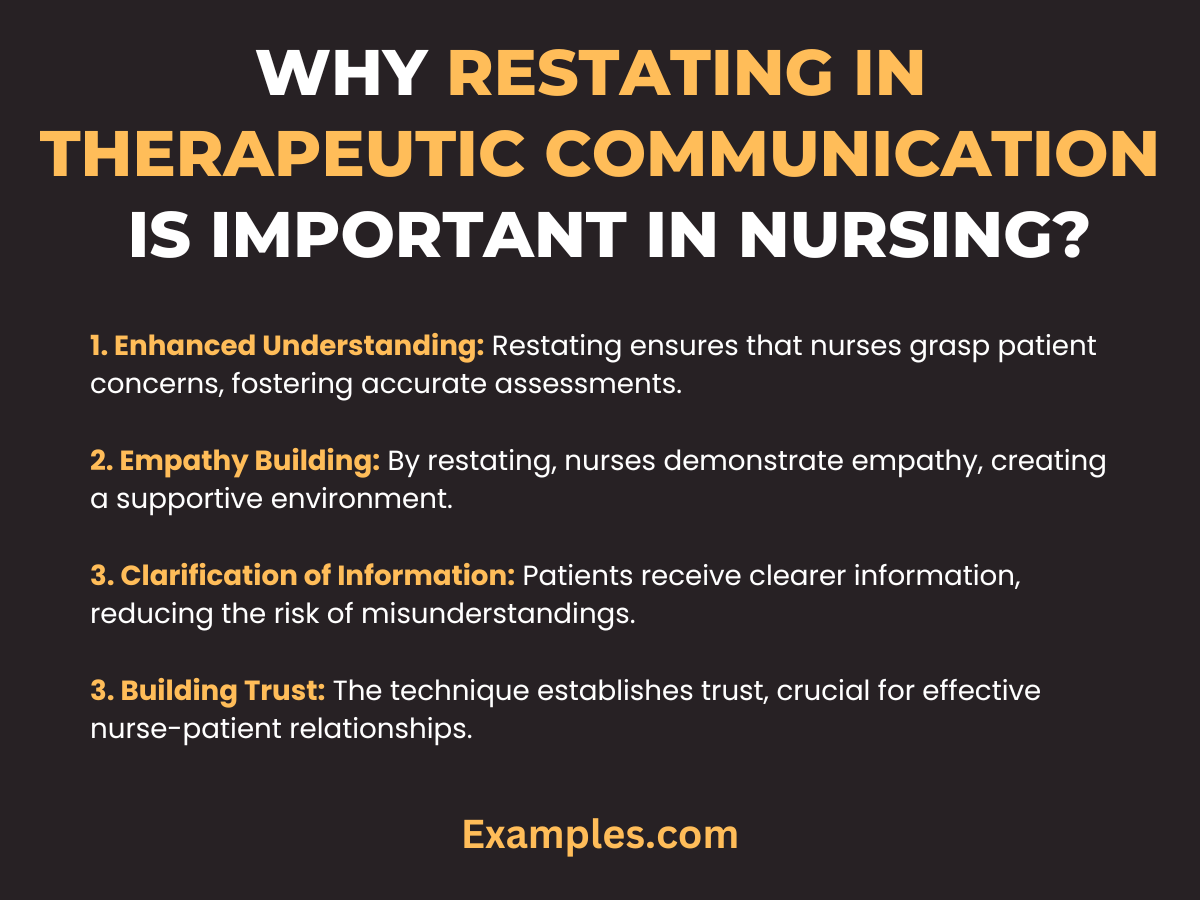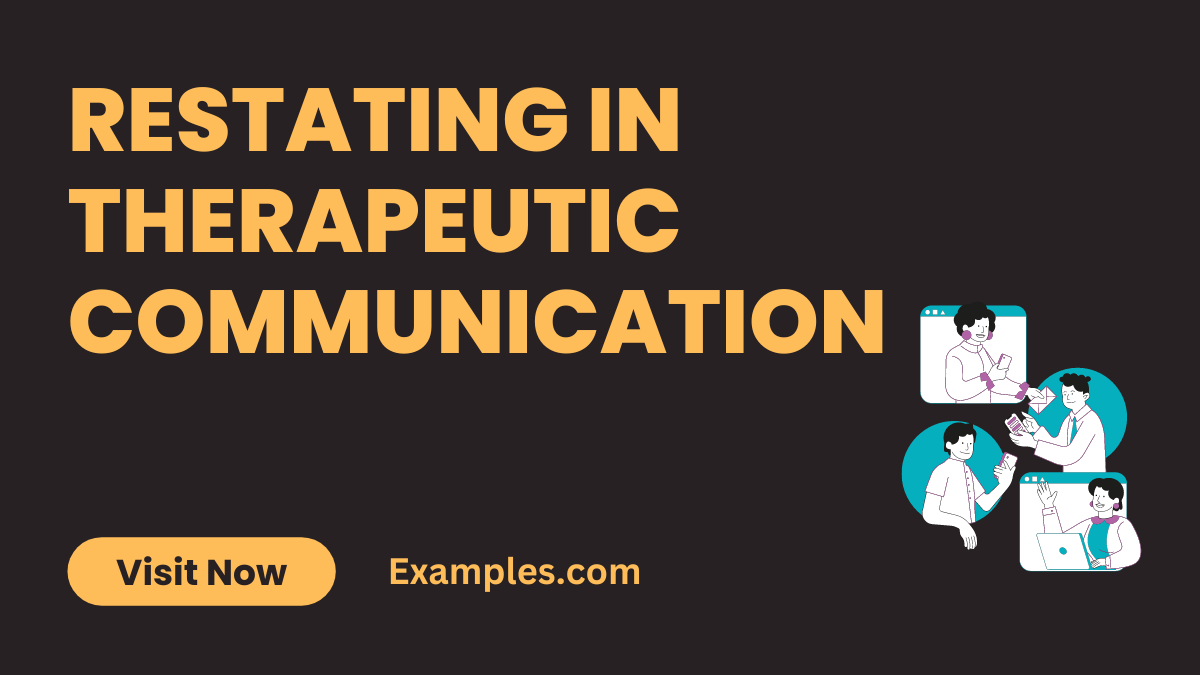19+ Restating in Therapeutic Communication Examples
Unlock the power of effective communication with our comprehensive guide on “Restating in Therapeutic Communication.” Elevate your interpersonal skills as we delve into practical examples that showcase the art of restating in therapeutic communication. Learn how strategic restating can foster understanding and connection, and explore communication examples that illustrate the impact of this valuable technique. Join us on this journey to enhance your communication prowess and navigate conversations with empathy and precision.
What is Restating in Therapeutic Communication?

Restating in therapeutic communication is a powerful technique that involves paraphrasing or repeating the main points of what someone has shared, emphasizing active listening. In simple terms, it’s expressing the speaker’s words in a slightly different manner to convey understanding and empathy. This method fosters a deeper connection, ensuring both parties feel heard and valued. Restating is a fundamental aspect of effective communication, promoting mutual understanding and emotional support in various interpersonal interactions.
20 Restating in Therapeutic Communication Examples

Explore the art of restating in therapeutic communication through vivid examples that illuminate its transformative impact. This comprehensive guide not only provides practical insights but also demonstrates how strategic restating enhances empathy and understanding. Elevate your communication skills by delving into these real-life scenarios, equipping yourself with the tools to navigate conversations with sensitivity and precision.
- Patient: “I feel overwhelmed with my treatment.”
- Therapist: “It sounds like the treatment is causing a lot of stress for you.”
- Client: “I’m struggling with self-doubt.”
- Counselor: “So, you’re experiencing doubts about yourself?”
- Friend: “I’m afraid of failing this exam.”
- Supporter: “It seems like you’re worried about not doing well on the exam.”
- Colleague: “I’m finding it hard to meet deadlines.”
- Co-worker: “Meeting deadlines is proving challenging for you, right?”
- Family Member: “I’m upset about our recent argument.”
- Relative: “The argument has left you feeling upset?”
- Student: “I’m anxious about presenting in class.”
- Classmate: “The idea of presenting in class makes you feel anxious?”
- Employee: “I’m overwhelmed with workload pressure.”
- Manager: “The workload pressure is getting to you, I hear.”
- Client: “I don’t feel understood in therapy.”
- Therapist: “It seems like you’re not feeling fully understood during our sessions.”
- Teenager: “I don’t think my parents trust me.”
- Parent: “So, you’re feeling that your parents lack trust in you?”
- Patient: “I’m scared of the upcoming procedure.”
- Medical Staff: “The upcoming procedure is causing fear for you, correct?”
- Friend: “I’m struggling with a recent breakup.”
- Confidante: “So, the breakup has been challenging for you?”
- Co-worker: “I’m frustrated with the team dynamics.”
- Team Member: “The team dynamics are causing frustration for you?”
- Family Member: “I feel distant from my siblings.”
- Sibiling: “It sounds like you’re sensing a distance with your siblings.”
- Student: “I’m confused about the assignment instructions.”
- Classmate: “The assignment instructions are a bit confusing for you?”
- Employee: “I’m not sure about my role expectations.”
- Supervisor: “So, you’re uncertain about your role expectations?”
- Client: “I don’t feel supported in my goals.”
- Counselor: “It seems like you’re lacking support in pursuing your goals.”
- Friend: “I’m feeling isolated lately.”
- Supportive Friend: “Lately, you’ve been feeling isolated, is that right?”
- Patient: “I’m hesitant about trying a new medication.”
- Healthcare Provider: “So, there’s hesitation about trying the new medication?”
- Teenager: “I don’t think my opinions matter at home.”
- Parent: “It sounds like you feel your opinions aren’t valued at home.”
- Employee: “I feel overlooked in team discussions.”
- Manager: “You’re sensing a feeling of being overlooked in team discussions, correct?”
Restating in Therapeutic Communication Examples for Nursing Students
Discover nuanced restating techniques tailored for nursing students to enhance communication in healthcare settings. This guide offers insights into restating methods uniquely relevant to the challenges faced in nursing education, emphasizing empathy and clarity in patient interactions. Elevate your skills with practical examples designed to resonate with the specific needs of nursing students, fostering effective communication within the healthcare environment.
- Student: “I’m anxious about my first clinical placement.”
- Mentor: “Feeling anxious as you approach your first clinical placement?”
- Nursing Student: “I find it overwhelming to balance coursework and practicals.”
- Instructor: “Balancing coursework and practicals is overwhelming for you, right?”
- Future Nurse: “I struggle with initiating tough conversations with patients.”
- Preceptor: “Initiating tough conversations with patients is a challenge for you?”
- Student Nurse: “I fear making a mistake during patient care.”
- Clinical Instructor: “The fear of making a mistake during patient care is on your mind?”
- Nursing Learner: “I’m unsure about choosing the right intervention.”
- Educator: “Choosing the right intervention feels uncertain for you?”
Restating in Therapeutic Communication Examples for Cancer Patients
Tailored for cancer patients, this guide navigates the delicate art of restating in therapeutic communication within the healthcare context. Offering compassionate examples and tips, it addresses the unique emotional challenges faced by those undergoing cancer treatment. Learn how restating can provide comfort, clarity, and support in discussing complex medical information, fostering a connection that goes beyond the clinical setting to empower patients on their cancer journey.
- Patient: “I’m scared of the upcoming chemotherapy session.”
- Oncology Nurse: “Feeling scared about the upcoming chemotherapy session, I understand.”
- Cancer Survivor: “I worry about the treatment’s impact on my daily life.”
- Supportive Counselor: “Worries about the treatment’s impact on your daily life are valid.”
- Individual with Cancer: “I’m struggling to express my concerns to the medical team.”
- Patient Advocate: “Expressing concerns to the medical team can be challenging, but it’s essential.”
- Cancer Warrior: “I feel isolated in coping with the diagnosis.”
- Support Group Leader: “Coping with the diagnosis can be isolating; you’re not alone in this journey.”
- Patient undergoing Cancer Treatment: “I don’t fully understand my treatment plan.”
- Oncologist: “Understanding the treatment plan fully is crucial; let’s go over it together.”
What is Restating in Therapeutic Communication Technique?
Restating in therapeutic communication is a technique centered around active listening and empathy. This method involves paraphrasing or repeating the core elements of what someone has expressed to ensure mutual understanding. Key aspects include:
- Active Listening: Restating emphasizes attentiveness to verbal and nonverbal cues.
- Paraphrasing: The technique involves expressing the speaker’s words in a slightly different manner.
- Empathy: Restating fosters a connection by demonstrating understanding and acknowledging the speaker’s emotions.
What are Restating in Therapeutic Communications Strategies?
Effective use of the restating technique requires strategic implementation. The following strategies enhance its impact:
- Reflective Language: Choosing words that mirror the speaker’s emotions and experiences.
- Clarification: Seeking additional information to ensure accurate restating.
- Timing: Selecting opportune moments to employ restating for maximum effect.
- Tonal Consideration: Aligning the tone with the speaker’s emotional context for authenticity.
Why Restating in Therapeutic Communication is Important in Nursing?

Restating holds significant importance in nursing, promoting optimal patient care and communication:
- Enhanced Understanding: Restating ensures that nurses grasp patient concerns, fostering accurate assessments.
- Empathy Building: By restating, nurses demonstrate empathy, creating a supportive environment.
- Clarification of Information: Patients receive clearer information, reducing the risk of misunderstandings.
- Building Trust: The technique establishes trust, crucial for effective nurse-patient relationships.
- Patient-Centered Care: Restating contributes to patient-centered care by acknowledging and addressing individual needs.
In conclusion, mastering restating in therapeutic communication is pivotal for cultivating empathy and building strong interpersonal connections. This comprehensive guide has explored the significance, strategies, and real-world examples, providing a roadmap for effective communication. Elevate your interactions by embracing this powerful technique, creating a positive impact on relationships in various personal and professional settings.



